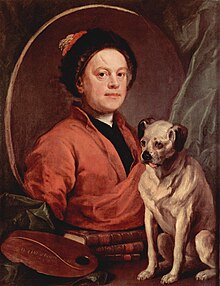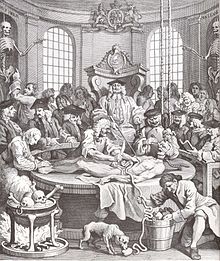The Four Stages of Cruelty
The Four Stages of Cruelty is a series of four printed engravings. They were published by the English artist William Hogarth in 1751. Every print is about a different part of life of Tom Nero, a fictional (not real) character.


The First stage of Cruelty shows Nero, when he is a child, hurting a dog. In the Second stage of cruelty, Nero, who is an adult, beats his horse. Then in Cruelty in perfection, he becomes a robber and murders his pregnant lover. At last, in The reward of cruelty, his body is taken from the gallows after his execution and is cut up into pieces by surgeons. This last annotation refers directly to the act of parliament then under consideration and passed in 1752 which changed the law to require the bodies of executed murderers to be surrendered to the surgeons for use in anatomy classes and only buried after they had been anatomized. The act was created in response to the increase in murders, especially in the suburbs of London.
William Hogarth, who had been very unhappy at the acts of cruelty that he saw on the streets of London, printed the pictures for moral learning. They were printed on cheap paper for poor people. The pictures are rougher and more violent than Hogarth's other works, which usually have touches of humor. He had felt he needed to do this to make people understand his message. However, the pictures still have the small, careful details that Hogarth is famous for.
History
changeLike most of his other prints, such as Beer Street and Gin Lane, Hogarth wanted The Four Stages of Cruelty to be a warning against cruel and evil acts, and that it was easy for a small bully to become a criminal. He wished to stop "that barbarous (mean) treatment of animals, the very sight of which renders (makes) the streets of our metropolis so distressing (terrible) to every feeling mind".[1] Hogarth loved animals. When he painted a portrait of himself, he included his pug in the picture. He also marked the graves of his dogs and birds at his home in Chiswick.[2]
Reception
changeHogarth was pleased with his pictures. European Magazine reported that he said to a person who sold books named Mr. Sewell:
...there is no part of my works of which I am so proud, and in which I now feel so happy, as in the series of The Four Stages of Cruelty because I believe the publication of theme has checked the diabolical spirit of barbarity (cruelty) to the brute creation which, I am sorry to say, was once so prevalent (common) in this country.
—European Magazine, June 1801
In his unfinished Apology for Painters he added:[3]
I had rather, if cruelty has been prevented (stopped) by the four prints, be the maker of them than the [Raphael] cartoons, unless I lived in a Roman Catholic country.
In his 1817 book Shakespeare and His Times, Nathan Drake said that picture in the first plate changed the opinion of people about "throwing at cocks", and encouraged them to be firmer about stopping the people who did these things.
Some people, however, did not like the series very much. Charles Lamb said that the series were not as good as Hogarth's other works.[4] Art historian Allan Cunningham also disliked the series:[5]
I wish it had never been painted. There is indeed great skill in the grouping, and profound (deep) knowledge of character; but the whole effect is gross, brutal and revolting. A savage (cruel) boy grows into a savage man, and concludes (finishes) a career of cruelty and outrage by an atrocious murder, for which he is hanged and dissected.
Gallery
change-
First stage
-
second stage
-
third stage
-
last stage
References
change- ↑ William Hogarth (1833). "Remarks on various prints". Anecdotes of William Hogarth, Written by Himself: With Essays on His Life and Genius, and Criticisms on his Work. J.B. Nichols and Son. pp. 64–65, 233–238 and 336.
- ↑ Uglow, Jenny (1997). Hogarth: a life and a world. Faber and Faber. p. 501. ISBN 0-571-16996-1.
- ↑ Gowing, Lawrence (1972). Hogarth. The Tate Gallery. SBN 8435-6035-5.
- ↑ Charles Lamb (1811). "On the genius and character of Hogarth: with some remarks on a passage in the writings of the late Mr. Barry". The Reflector. 2 (3): 61–77.
- ↑ Allan Cunningham (1831). "William Hogarth". The Lives of the Most Eminent British Painters and Sculptors. J and J Harper. p. 57.